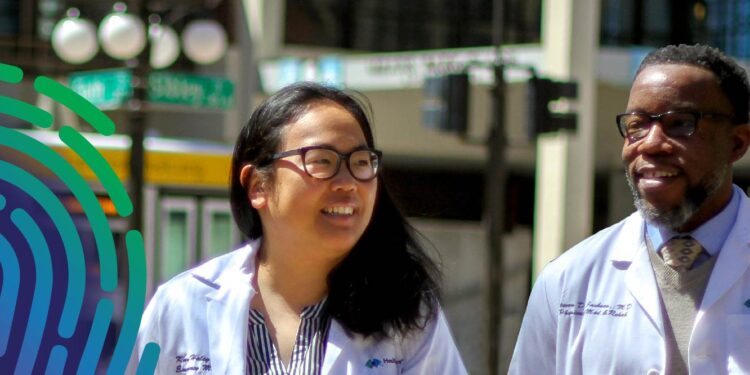Stephanie Zahrbock misplaced all sensation and the power to maneuver or really feel something under her stomach button over the course of 1 month in 2016. The former runner shares how her world modified and how options to the challenges she faces can profit everybody. Listen to the episode or learn the transcript.
A sudden and surprising change
In October 2016, Zahrbock was a healthy 45-year-old. Married with two youngsters, she had accomplished 25 half marathons and confirmed no indicators of slowing down. That is till she observed her left foot dragging a bit.
Just the weekend earlier than, Zahrbock ran 22 miles, which wasn’t uncommon for her. She needed to be a little extra acutely aware of her left foot, however in any other case carried on as regular. Then her left pinky started to lose mobility – Zahrbock observed it took extra effort to hit the shift key when typing. Soon after, at an occasion on the then-new U.S. Bank Stadium, she remembers feeling “really unsteady” on her toes.
Zahrbock, who’d solely had an OB-GYN and an endocrinologist up till that time, determined it was time to make an appointment with a major care physician.
Her new major care physician at Park Nicolett did a gait evaluation and decided Zahrbock wanted an MRI, sooner somewhat than later. That night time, she had her first MRI. She was getting ready to depart when the tech stated her physician wished to speak to her immediately.
“The doctor had a horrible case of laryngitis,” Zahrbock remembers, so understanding the information was that rather more tough. The physician stated that Zahrbock had indications of a number of sclerosis (MS). From there, Zahrbock went by means of a sequence of spinal faucets and blood patches to restore harm accomplished by spinal faucets. Finally, on Halloween, medical doctors decided that it was MS. Meanwhile, Zahrbock’s strolling continued to degrade, and her mobility was turning into more and more restricted.
“I was in the best shape I could possibly be,” she says. “I went to City Hall to vote. And then on November 6th, I was unable to bear weight on my legs.” Zahrbock rapidly misplaced all sensation and means to maneuver something under her stomach button. The medical doctors concluded that this was due to a lesion on her backbone, and her prognosis was adjusted to incorporate the likelihood that it could possibly be a situation usually related with MS known as neuromyelitis optica (NMO). But, due to her already ongoing MS remedy, the exact trigger couldn’t be decided.
Moving ahead
Everything has been secure for the reason that fall of 2016, when Zahrbock’s life all of the sudden modified. Like her actual prognosis, Zahrbock says the stabilizing of her situation can be a thriller.
The issue of adjusting to life as a wheelchair consumer, nonetheless, was no thriller.
“The biggest part was mental, not physical,” Zahrbock says. The psychological and emotional journey was much more diverse and tough, she says, than coming to phrases with her bodily limitations.
“There’s no break from this,” she says. “I will be a wheelchair user and paraplegic all my life.”
Another actuality to return to phrases with is one Zahrbock is attempting to alter: She’s discovered that it’s a widespread false impression for individuals who see wheelchair customers to imagine some type of cognitive impairment as properly.
“People will talk to my husband instead of me,” she says. Zahrbock says she’s skilled this in all places, from airplanes to eating places and past.
Using her privilege
Despite the adversity Zahrbock experiences frequently, she says she has a lot of privilege.
“I have the privilege of being cognitively unimpaired. English is my first language, and I am a white person,” she says. She advocates for wheelchair customers, she says, “because I want to be sure that those who don’t have these privileges can also benefit from them.”
In health care, she notes, accessibility points are a matter of benign neglect.
Zahrbock says she’s spoken out about wheelchair-accessible scales at her OB-GYN’s workplace, accessible doorways at her urologist and the so-called “wheelchair protocol” with mammography appointments.
“There’s protocol for wheelchairs,” she says. “But just because there’s a protocol in place doesn’t mean you can’t look at the person in front of you and say, ‘Oh wait that doesn’t apply here.’”
Using a wheelchair as a girl … in Minnesota
Most individuals who use wheelchairs, Zahrbock says, are males of their 20s and 30s. The options that work for them are completely different from what may work for a girl in her 50s.
“My muscles are bigger than they’ve ever been,” she says. But the options skew in the direction of individuals who have extra higher body strength.
Additionally, the challenges of utilizing a wheelchair are completely different for folks in numerous climates. Minnesota presents some obstacles.
“There are lots of things to think about that other people don’t,” she says. Among the issues Zahrbock faces when going out within the winter are whether or not or not there’s coated parking, dealing with wheels coated in salt and grit, and discovering gloves that stand up to the damage and tear of working a wheelchair.
Opportunities that come from utilizing a wheelchair
“If it’s accessible for me, it’s accessible for everyone,” says Zahrbock. She says that wheelchair customers are “a community that anyone can join instantly,” so it is sensible to make accessibility enhancements.
“You might be doing work for yourself at some point,” she says. “I never knew I’d be part of this community, but a large amount of us are headed here. I just got here early.”
The expertise of all of the sudden turning into a part of the wheelchair-using neighborhood was laborious on the entire Zahrbock household. But she says that it’s allowed all of them to suppose extra fastidiously about what they do with their time and alternatives.
Both of Zahrbock’s youngsters have opted to take a while to do the issues they’re fascinated about somewhat than go straight from faculty to work. “They see they don’t have to work, work, work,” she says. “They can time the time to do the things they want to do. The stuff that makes life worth living.”



















Discussion about this post